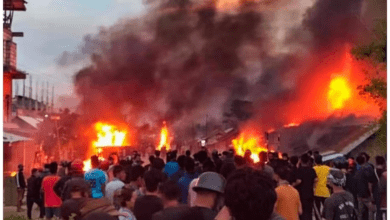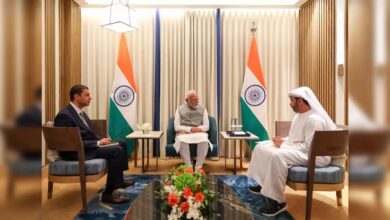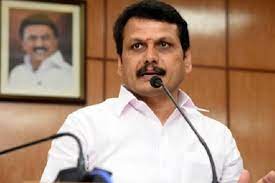The BJP manifesto describes “Bharat’s” future course
The party’s manifesto’s parts on international affairs are being extensively examined by foreign governments and Indian experts amid predictions that the BJP would win the Lok Sabha elections and PM Narendra Modi will continue to hold office. The booklet outlines the objectives for the next years as well as the accomplishments of the Modi administration’s foreign policy during the last ten years.

The term “Bharat” appears often in the English translation of the manifesto, which is the first startling feature. This also holds true for the parts on foreign policy. It is now customary for the Modi administration to refer to the nation as “Bharat” rather than “India” in many contexts. In addition to the term “India’s” constitutional precedence, the word also serves as the foundation for this nation’s contemporary worldwide identity. India is referred to by this designation in the UN and is how it is recognized around the globe. Nonetheless, certain politicians in India have used the English language to refer to India as “Bharat.” The most noteworthy instance was perhaps President Droupadi Murmu, who was referred to as the “President of Bharat” in her G20 invitation to international leaders last year.
Nations do rename themselves. For example, in 1989, Myanmar, then known as Burma, changed its name and notified the UN of the change. There are no internationally recognized guidelines for nation-state name changes. The international community just has to be notified by sovereign governments for the name change to be approved. Governments must, of course, fulfill internal constitutional procedures in order to do this. Because they did not recognize the military administration that had altered the name, many Western nations continued to refer to Myanmar as Burma.
Some observers may wonder whether the Modi administration would attempt to amend the constitution during its third term to rename the nation “Bharat” in the English language. This will align with its philosophy. Naturally, no foreign force would have any trouble using “Bharat” instead of “India” when the constitutional amendments are implemented. Since the Muslim League had claimed that “India” was obsolete and that the two “successor” governments should be referred to as “Pakistan” and “Hindustan” at the time of the Partition, Pakistan would be pleased that our nation is now known as “Bharat.”
The government’s 11 accomplishments are enumerated in a section of the manifesto headed “Bharat on the global stage.” The effective removal of Indians from combat zones and hosting the G20 summit rank first and second, respectively. Without a question, both the summit’s final paper and the successful return of Indians in distress from war zones were diplomatic triumphs in the polarized global environment.
But earlier administrations also helped Native Americans during hard times. Furthermore, the Modi administration has taken pride in speaking for the Global South. It is true that India is admired by many nations in the Global South, but this is not particularly unusual. Over the years, New Delhi’s contribution to decolonization and its leadership in defending the interests of the Global South in all of its guises—developing, Third World, and impoverished nations—have come to be recognized.
One section’s title, “Modi ki Guarantee for Vishwa Bandhu Bharat,” is intriguing since it promises that PM Modi, not India, would act in the global interest. In fact, he is providing assurances to the whole globe in the same way that he has done for the Indian people. It’s also notable that the term “Vishwaguru” is absent.
“We will strengthen our position and conduct our policies to further our national interests with the spirit of Vishwa Bandhu,” reads the last phrase of this section’s introduction. Stated differently, Modi has pledged that India would avoid the road of pursuing purely national interests and instead work to reconcile Indian interests with those of the world. Although the PM is displaying a laudable inclination, is it realistic in a society when the status quo is being challenged? Furthermore, how does it reconcile with the claim of a foreign policy that puts “Bharat First”?
Of the ten goals and avenues for exploration listed in this section, eight are not brand-new. For instance, India’s diplomatic agenda over the last three decades has included efforts to increase international cooperation against terrorism and become a permanent member of the UN Security Council. The BJP’s efforts to form alliances for mineral security are commendable, since manufacturing has to be encouraged.
The Middle East-Europe-India Economic Corridor is a proposal that will be challenging to carry out, nevertheless. Further complicating the Neighbourhood First policy’s pursuit is China’s incursion into India’s near neighborhood. The fact that External Affairs Minister S Jaishankar has repeatedly accepted this truth is commendable, but recognition alone does not advance India’s objectives.
The manifesto places special emphasis on advancing Indian soft power in the third part on foreign policy. The first is about the Thiruvalluvar cultural centers, which were built with the intention of promoting Indian customs. It’s unclear how they will vary from the existing Indian cultural centers serving the same purposes. Will the latter take on a new name, or will they both exist at the same time?
As stated in the manifesto, “We will initiate a worldwide outreach program for recording and advancing Lord Ram’s material and immaterial legacy throughout all nations.” There are a number of Ramayana versions throughout Southeast Asia that vary significantly from the official version in India, making this a contentious topic. How will the BJP handle the inevitable controversy that these versions would bring about?







